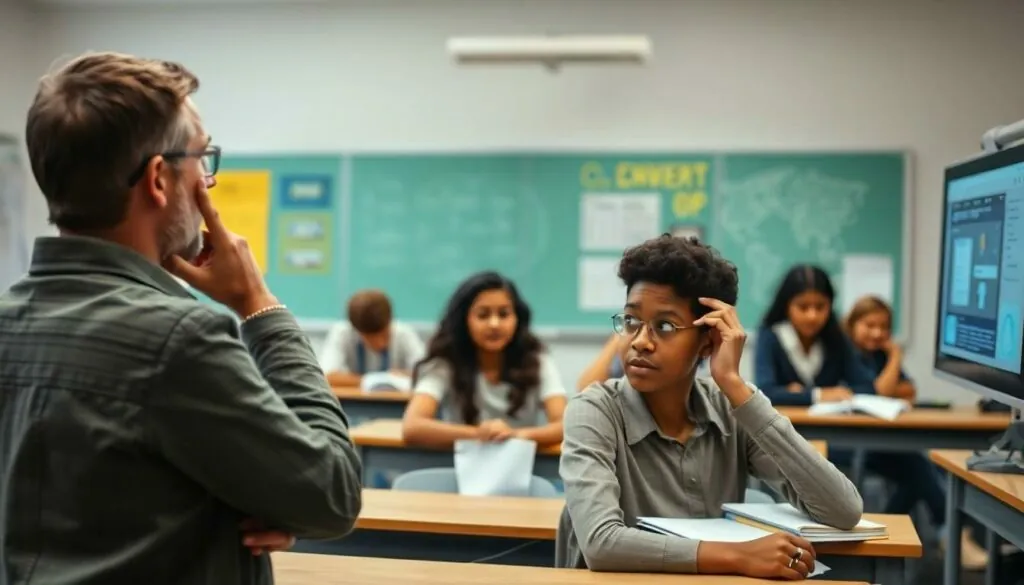Table of Contents
ToggleIn a world where students can whip up essays faster than they can say “ChatGPT,” schools are on a quest to outsmart the digital age. Imagine a classroom where teachers wield the power of technology to sniff out AI-generated content like a bloodhound on a mission. It’s not just about catching cheaters; it’s about ensuring genuine learning in an era where creativity and originality are at stake.
But how can schools effectively detect the sneaky handiwork of ChatGPT? With a mix of innovative tools and a dash of human intuition, educators are gearing up to tackle this challenge head-on. As they navigate this brave new world, they’ll need to balance tech-savvy strategies with a healthy dose of humor and understanding. After all, who knew that teaching integrity could feel like a high-stakes game of hide and seek?
Understanding ChatGPT
ChatGPT represents a significant advancement in AI-driven text generation. This tool enables users to produce coherent and contextually relevant content quickly.
What Is ChatGPT?
ChatGPT is a language model developed by OpenAI. It enhances interactions through natural and fluid text generation. This model has been trained on diverse internet text, allowing it to understand and generate human-like responses. AI-driven tools like ChatGPT enable students to create essays, engage in conversation, and answer questions effectively. However, its rapid integration into academic settings raises concerns about originality and academic integrity.
How Does ChatGPT Work?
ChatGPT operates using deep learning algorithms. These algorithms analyze the context of input data, predicting subsequent text based on learned patterns. During training, the model ingests extensive datasets, enhancing its ability to generate relevant text. It utilizes transformers, a type of architecture ideal for understanding relationships in language. Students might find that responses often reflect the prompts given, demonstrating reliance on context. This combination of machine learning and vast datasets allows ChatGPT to produce highly sophisticated outputs.
The Need for Detection

Detecting AI-generated content, especially from ChatGPT, is essential for maintaining academic integrity. Schools face challenges in assessing students’ authentic work as technology evolves.
Why Schools Should Detect ChatGPT Usage
Educational institutions must ensure students genuinely engage with learning material. Identifying ChatGPT usage helps maintain personal growth and academic honesty. Without detection, reliance on AI tools can stifle critical thinking and creativity. Furthermore, detecting AI-assisted submissions promotes accountability, pushing students to develop their skills rather than resorting to shortcuts.
Potential Consequences of Undetected Use
Undetected AI usage poses significant risks for students and educational institutions. Plagiarism becomes more prevalent, undermining the value of genuine academic achievement. Additionally, the quality of education suffers when students lean on artificial intelligence for assignments. When AI-generated content remains unchecked, institutions may face tarnished reputations for academic rigor. This situation cultivates a culture of dishonesty, which can discourage students from fully realizing their potentials.
Methods of Detection
Detecting AI-generated content like that produced by ChatGPT involves a combination of manual techniques and advanced technological solutions. Schools can utilize various strategies to ensure academic integrity.
Manual Detection Techniques
Educators rely on manual detection techniques to identify AI-generated essays. Examining writing style and unusual phrasing often reveals inconsistencies with a student’s typical work. Instructors can undertake direct communication with students about their writing process, allowing them to gauge authenticity. It’s crucial to pay attention to depth of knowledge displayed in essays, as AI may lack nuanced understanding. Finally, encouraging classroom discussions helps reveal whether a student comprehends their submitted work.
Technological Solutions for Detection
Schools are increasingly adopting technological solutions to combat AI-generated content. Several tools analyze writing patterns and flag texts that demonstrate signs of AI assistance. These solutions often employ algorithms designed to evaluate syntax, semantics, and coherence, identifying inconsistencies. Programs like Turnitin and similar plagiarism detection tools continuously update their capabilities to include recognition of AI-generated work. Collaboration with tech developers leads to the creation of unique detection software tailored for educational environments. Embracing these innovations strengthens the fight against academic dishonesty.
Best Practices for Schools
Schools can adopt various strategies to effectively detect AI-generated content, like using ChatGPT, while maintaining academic integrity. By combining technology with innovative teaching methods, institutions can address this evolving challenge.
Educating Students About AI Use
Educators should guide students in understanding the implications of AI in their work. Awareness about the ethical use of AI fosters integrity in academic environments. Schools can hold workshops and discussions that emphasize critical thinking, encouraging students to evaluate the authenticity of their sources. Clear policies regarding AI usage can also reinforce expectations. Incorporating lessons about originality and the value of personal expression bolsters students’ connection to their own work while discouraging reliance on AI-generated content.
Implementing Detection Tools
Schools need to invest in effective detection tools that can identify AI-generated content. Programs like Turnitin have enhanced their capabilities to detect such texts, making them valuable resources. Advanced software employs algorithmic analysis to differentiate between human and AI writing styles. In addition, schools can collaborate with tech developers to create customized detection solutions that align with educational standards. Training faculty to use these tools effectively ensures that they can accurately assess the authenticity of student submissions. Integrating technology into the assessment process helps maintain academic integrity within the learning environment.
Future of Detection in Education
As AI technologies evolve, educational institutions face continuous challenges. The development of new AI tools often outpaces detection methods. Schools must adapt to these advancements by enhancing their technology and detection strategies. Collaboration with AI developers and continuing to refine existing detection algorithms become critical to this effort. Using diverse data sets, these advanced tools can identify nuances in AI-generated content more effectively.
Evolving AI Technologies
AI technologies continue to progress rapidly, leading to more sophisticated text generation capabilities. Enhanced natural language processing allows AI tools to produce outputs that closely resemble human writing. Newer models are becoming increasingly harder to distinguish from student work. This trend necessitates regular updates to detection tools to keep pace with advancements. Input from educators and students can inform these refinements. Schools can utilize machine learning techniques to improve the accuracy of detection, enhancing their ability to spot artificial content.
Anticipating Future Challenges
Future challenges in detecting AI-generated content will emerge as technology shifts. New AI systems may employ advanced algorithms that create even more indistinguishable texts. Anticipating these changes requires ongoing research and investment in detection technology. Schools need to prepare for an influx of students using AI in their work. This preparation entails developing clear and adaptive policies regarding AI usage. Engaging in proactive conversations about academic integrity can help mitigate risks associated with undetected AI content. Training faculty and staff on these evolving tools will ensure a more effective education experience.
The challenge of detecting AI-generated content in schools is an ongoing battle that requires a multifaceted approach. By combining technology with human insight educators can create an environment that promotes originality and academic integrity. The use of advanced detection tools alongside traditional methods offers a robust solution for identifying AI usage.
As the landscape of education continues to evolve with AI advancements it’s essential for schools to adapt and invest in effective strategies. Fostering a culture of honesty and critical thinking among students will not only enhance learning but also prepare them for future challenges. Ultimately maintaining academic integrity is vital for nurturing genuine growth and success in education.



